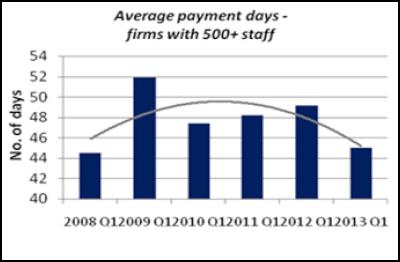Big Businesses Quicker to Pay
Big Businesses Quicker to
Pay
Stronger economic conditions aiding cash
flow
Big businesses have cut the time taken to
pay their bills by more than four days over the past 12
months and further improvements are expected in the months
ahead. These findings come as the New Zealand economy begins
to pick-up and business optimism improves, with average
payment times for businesses across the board dropping 1.9
days to 43 days in the March quarter 2013.
These
findings are from the latest Dun & Bradstreet (D&B) Trade
Payments Analysis, which examines the millions of
accounts receivables records contained on the D&B database.
The analysis reveals that firms employing 500+ staff reduced
their payment times to 45 days, the biggest year-on-year
improvement across firms of all business sizes.
This has come down from the peak of 52.4 days
recorded during the height of the Global Financial Crisis
(December quarter 2008) but has not recovered to the levels
seen in the March quarter 2008. Based on historical data,
D&B analysis expects payment times to further drop to 41.6
days in the June quarter 2013.


According to D&B New Zealand’s General Manager, Lance Crooks, the results show that many of New Zealand’s corporations are making an effort to shorten their payment cycles.
“Stronger economic conditions and low interest rates have had a positive impact on the cash flow position of many firms. This has enabled companies to better manage their incomings and outgoings, and consequently, many firms are now able to pay earlier in the payment cycle.”
“It is extremely positive to see corporations making more of an effort to reduce payment times to levels usually seen in smaller firms.
“Despite payment times for large companies fluctuating over the past six years, the long-term trend is encouraging, with payment times almost falling to pre-GFC levels seen in the first quarter of 2008.”
D&B’s findings align with official Treasury data1 indicating strong GDP growth in the December quarter of 2012, its strongest growth rate since 2008. Business confidence is also at above-average levels, signalling ongoing strength in the first half of 2013.
Additional D&B data also reveals the gap between small and large business payment times has narrowed since 2009 – firms with 500+ staff took three days longer to pay their bills than those with one to five staff in the first quarter of 2009, compared to 1.7 days over the same quarter in 2013. Payment times for firms with 500+ staff were also 4.5 days longer than payment times for firms employing six to 19 staff in the March quarter 2009. This figure dropped to 2.9 days in the March quarter 2013.
According to D&B’s Economic Advisor, Stephen Koukoulas, the drop in payment times for big business continues the run of favourable news in New Zealand.
“The trend towards faster bill payment reflects the cashed-up position of firms, which are being helped along by a gentle pick up in the real economy and the maintenance of record-low interest rates from the RBNZ,” said Mr Koukoulas.
“Historical data shows that when economic times are tough, firms are slower to pay their bills than when times are good. The news of falling payment times is a sure sign that the economy is slowly but surely recovering.
“While there has been a slight variation in payment times across firms of different sizes, the trend towards quicker payment times is evident across the board over the last two years,” Mr Koukoulas added.
Examining location data reveals that Auckland firms were the slowest payers at 45.3 days, longer than the 43 days recorded in Wellington and 42.6 days in Christchurch. In particular, firms based in Wellington experienced the biggest improvement, cutting payment times by five days year-on-year. This comes off the back of the film premiere of The Hobbit late last year, which added an estimated $11.7 million to Wellington’s economy in tourism and direct contributions2.
Industry-wise, firms in the Electric, Gas and Sanitary Services sector showed the greatest year-on-year improvement in payment terms (down eight days to 42.1).The fastest payers were those in the Agriculture industry at 38.2 days, down two days year-on-year. This aligns with D&B’s long-term trend data, which shows Agriculture firms are typically some of the quickest payers.
The slowest payers continued to be businesses in the Communications industry, averaging 48.5 days to pay their bills (down 3.7 days year-on-year) followed by the Finance industry at 43.9 days (down 0.8 days year-on-year). Manufacturing companies were also among the slowest payers at 43.9 days in the March quarter following a fall in December quarter GDP for the petroleum, chemical, plastic and rubber products manufacturing sub-sectors, according to Treasury figures1. Retail and Forestry were the only industries to show deterioration, down 0.3 days and 0.5 days year-on-year to 42.7 days and 41.3 days respectively.
1This is according to the New Zealand Treasury’s Monthly Economic Indicators for March 2013, which can be found here.
2This is according to the Office of the Mayor, Wellington. The full article can be found here.
ENDS


 Business Canterbury: Urges Council To Cut Costs, Not Ambition For City
Business Canterbury: Urges Council To Cut Costs, Not Ambition For City Wellington Airport: On Track For Net Zero Emissions By 2028
Wellington Airport: On Track For Net Zero Emissions By 2028 Landcare Research: ANZAC Gall Fly Release Promises Natural Solution To Weed Threat
Landcare Research: ANZAC Gall Fly Release Promises Natural Solution To Weed Threat NZ Anti-Vivisection Society: Auckland Rat Lovers Unite!
NZ Anti-Vivisection Society: Auckland Rat Lovers Unite! University of Canterbury: $1.35 Million Grant To Study Lion-like Jumping Spiders
University of Canterbury: $1.35 Million Grant To Study Lion-like Jumping Spiders Federated Farmers: Government Ends War On Farming
Federated Farmers: Government Ends War On Farming



